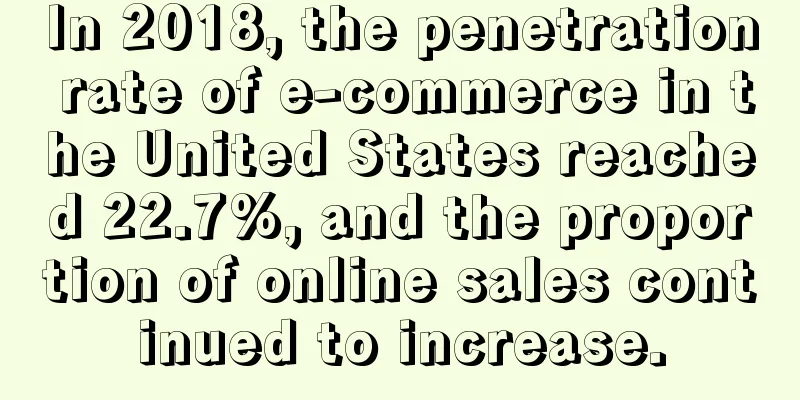In 2018, the penetration rate of e-commerce in the United States reached 22.7%, and the proportion of online sales continued to increase.

|
It is learned that on March 3, according to foreign media reports, according to Digital Commerce 360's analysis of US Department of Commerce data, the US e-commerce penetration rate will reach 22.7% in 2024, a new high. At the same time, e-commerce sales will increase to approximately US$1.2 trillion, more than double that of five years ago. It is understood that since the U.S. Department of Commerce began tracking e-commerce penetration in 2000, the proportion has increased almost every year. In 2022, the U.S. e-commerce penetration rate was 20.7%, a slight decrease from 20.8% in 2021. But by 2024, this proportion exceeded 22.7%, indicating that the share of e-commerce in the retail market continues to increase. Since 2020, e-commerce sales have always accounted for at least one-fifth of total U.S. retail sales, showing that online shopping has become an important choice for consumers. Image source: Digital Commerce 360 E-commerce sales are also growing significantly faster than the overall retail market. In 2024, U.S. e-commerce sales will grow by 7.5% year-on-year, more than twice the growth rate of total U.S. retail sales (2.6%) during the same period. Since the Ministry of Commerce began collecting relevant data, e-commerce sales have continued to grow every year without a decline. Even as the dividends from the epidemic gradually fade, the e-commerce industry has maintained steady expansion. Image source: Digital Commerce 360 In the long run, the growth momentum of the US e-commerce market mainly comes from multiple factors, including changes in consumer habits, the popularity of digital payments, and the continuous optimization of e-commerce platforms and logistics infrastructure. In 2024, e-commerce sales of approximately US$1.2 trillion doubled from US$571.09 billion in 2019, reflecting the profound impact of the e-commerce industry since the epidemic. In addition, e-commerce sales in 2023 increased by 7.5% year-on-year, which, although lower than the high growth level in the early 2020s, still consolidated the previous market expansion trend. As the penetration rate of e-commerce continues to increase, the competitive landscape of the US retail market will further tilt toward online in the future. Author ✎ Rayna/ Statement: This article is copyrighted and may not be reproduced without permission. If you need authorization, please contact: happy |
Recommend
How can a new account obtain advanced A+ features as quickly as possible?
You can directly see Advanced A+ on the Create A+...
Amazon launches new delivery method? It is being piloted on a small scale
Since Amazon restarted its replenishment restrict...
Weak demand and excess capacity mean U.S. express delivery companies are struggling during the holiday season
According to Reuters, in the past few years of the...
Fake reviews are strictly prohibited! Following the wave of account bans, Amazon sued two companies again!
As we all know, reviews have always been a hot top...
Home handicrafts are very popular, these 8 platforms are worth a try
<span data-shimo-docs="[[20,"今年由于疫情原因,家居装饰...
What is Yahoo! Japan? Yahoo! Japan Review
Yahoo Japan is a portal website operated by Yahoo ...
What is an Amazon buyer account? Amazon buyer account review
There are various differences in the buyer account...
What is WindPayer? WindPayer Review
WindPayer is located in Hong Kong, Shenzhen and Fu...
What is Dianti ERP? Dianti ERP Review
Dianti ERP is a SaaS system under Shenzhen Blue Ma...
Will the UK tax-inclusive FBA service be cancelled? Logistics and shipping costs have risen three times!
Recently, rumors that "freight forwarders hav...
Singapore e-commerce trend report: Live streaming discussion popularity increased by 1890%
According to a joint study by media intelligence c...
What are Search Terms? Search Terms Review
Search Terms are Amazon product keywords, which ar...
What is AMS? AMS Review
AMS (Amazon Marketing Services) is a self-service ...
How to drive external traffic to your Amazon page?
According to relevant statistics, only 75% of sale...
Shipping costs have started to rise for three consecutive times?! Frequent customs inspections?
Shipping freight rates, which have been plummeting...









